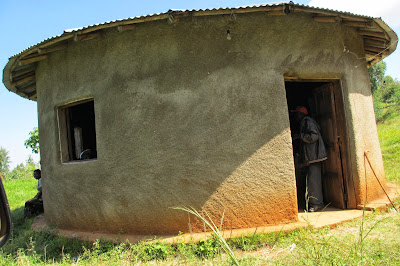 We arrived at the clinic, a one room, round hut-like meeting place, with a post in the middle, metal roof, three windows and a doorway. When we walked inside men and women were sitting along the rounded wall on benches. At a table, next to the entrance, health workers wearing white coats stood and sat with paperwork in hand conversing in hushed tones. Fileka, one of the health workers, whom I previously met, was speaking in the Walaita language to the people sitting around the room.
We arrived at the clinic, a one room, round hut-like meeting place, with a post in the middle, metal roof, three windows and a doorway. When we walked inside men and women were sitting along the rounded wall on benches. At a table, next to the entrance, health workers wearing white coats stood and sat with paperwork in hand conversing in hushed tones. Fileka, one of the health workers, whom I previously met, was speaking in the Walaita language to the people sitting around the room.As Sharon and I sat at the opposite side of the room, curious faces watching us, I noticed that most of the men and women had taken their shoes off and had placed their feet on top of their shoes. A few pairs of feet looked a bit swollen but otherwise fairly healthy. These were feet that previously had Podoconiosis, the unsightly foot disease, but now had no obvious traces of it. Around the room sat patients that where successfully treated.
The purpose of their visit that day was to either apply for or give a report for Self-Help Loans. The loans are offered only to fully treated MFP (Mossy Foot Project) patients. The process that each beneficiary, as the borrowers are called, must go through in order to apply and qualify for the loan is thorough. Accountability is evident. Once the loan is received it is used to begin a business, which could be as simple as purchasing a cow and selling the milk. Eventually the beneficiary is able to support themselves and even send their children to school. The transformation is life changing.
Before treatment, a person with mossy foot is shunned. A young girl could grow up in a hut, supported only by her parents. In one such testimony a young woman said that when someone came to her to tell her about MFP and the treatment she could receive at the clinic, she responded by saying that she didn’t want to go because she hadn’t conversed with people ever since she was a little girl. Podoconiosis, also known as mossy foot, causes a swelling of the feet and legs and can be accompanied by a foul smell. As can be imagined it is painful to walk. The young woman later did go to the clinic once she learned that the service was free and received treatment as well social and spiritual support. She now has her own business and says that now others want to be friends with her.
Prevention: a pair of shoes. It’s that simple. So why don’t all children, men and women wear shoes? Simply, poverty and lack of knowledge and awareness. Most people in the outer city area cannot afford a pair of shoes. Thus, mossy foot disease is prevalent. MFP is not only helping treat the sick but also fight the root of the problem, poverty, by providing the Self-Help Loans.
After many handshakes and few broken-English greetings and my broken-Amarik, more like two words, Sharon and I walked outside. Patients in-treatment where sitting just outside the clinic. This is where I met Bakale Bafe, mentioned in my previous blog post. Please continue to pray for him, God has a beautiful plan for him.
What happened next was just fun. Sharon was talking with the health workers and I was standing amongst women who surrounded me. One of the women was sitting on a bench clearly talking about me and chuckling with others as she pointed at my scarf. I imagined she was saying something like, “Be there a little breeze and her scarf will blow away.” She made hand motions as she spoke showing how my scarf was loosely hanging over my shoulder. I took my scarf off and presuming that I was correct in translating “Walaitan hand motions” asked the woman next to me to show me how to properly wrap the scarf. We went back and forth in the different languages, but she couldn't understand what I was asking of her until I turned around, knelt down and handed her the scarf. Immediately her face brightened up with understanding. The women became excited, laughter and chatter broke out. The head covering was wrapped as it should be, and I wore it thus for the remainder of the day.
I truly hope you enjoyed reading about my visit to one of the Mossy Foot Project clinics as much as I enjoyed being there! I will write more about the trip, my experience, and what my role was in Sodo. Stay tuned! Please pray for the Mossy Foot Project, the staff and patients. Sharon will be flying back on December 14th. Please pray for her stay in Ethiopia as well as her safe return home.
Here are the links to the Mossy Foot Project website:
MossyFoot.com
MossyFoot.com/gift – MFP Christmas Catalog!
For those of you, who generously supported me on this trip, THANK YOU!



